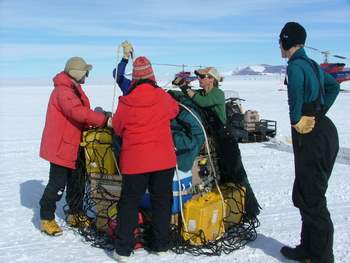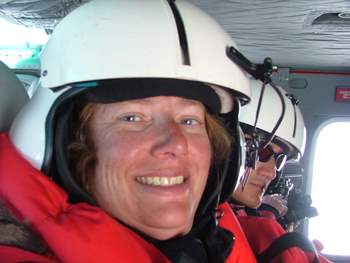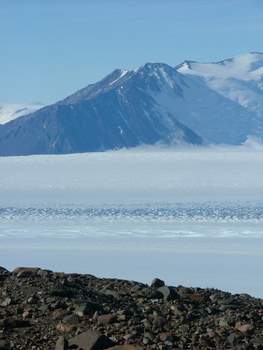Our scheduled helicopter flight to Cloudmaker Peak was right on time. We met with the pilot and helicopter (helo) technician at 12:45 to discuss cargo priorities and load the helicopter. The first flight would carry five of us, John, Brenda, Gordon, Perry, and myself along with gear to find a campsite. After getting the gear for the first flight loaded onto the helicopter, we went with the helo tech and helped her load the two slings the helicopter would carry for the second flight. This was an interesting process. She showed us how to lay out the netting and how to arrange the load so the weight was evenly distributed. Once all the boxes were stacked, we pulled the netting up and around the stack of boxes and cinched the rope tight against the swivel hook. The second sling contained our tents in a vertical position. These were a little trickier to assemble because they needed to be oriented so that nothing like tent poles would fall through the netting. Once the tents were oriented in the correct position and securely tied together, the netting was wrapped around them and then cinched down tight. This sling was attached to the first with another swivel hook.

Once we'd helped the helo tech assemble the slings, we were ready to set off on our flight. I was very excited for my first helicopter ride! We had a brief instruction on how to approach the helicopter when the rotors are turning and how to communicate with the pilot through hand signals. Then, it was time to don our flight helmets! I felt like I'd just stepped onto the set of Top Gun! We climbed into the helicopter and strapped ourselves in and it was time to go. John and Brenda both had the window seats because they needed to be able to quickly scout the field area and determine where the best location for our camp would be. (Our camp needs to be centrally located to features of interest.) While I would have liked to sit right by the window, I was able to get many great photos of the glaciers and mountains as we flew over them. Sometimes I was even able to crane my neck and look out over the helo tech's shoulder.

After about 45 minutes of flight, we approached our field area. We made two passes alongside the mountain, looking at features. Once John and Brenda decided on a central area, the pilot had to find a relatively level area for the helicopter to set down. This took quite a bit of searching since we are here to map and sample glacial moraines. Moraines have very uneven, hummocky surfaces made up of everything from sand-sized particles to car-sized boulders. We were fortunate that the winds were calm or this would have been much more difficult.
Once the pilot found a suitable landing site, we quickly exited the helicopter and began to unload our gear and carry it a safe distance - about 50 yards - from the helicopter. We weighted all of the gear down with rocks before the helicopter took off to keep it from being blown by the draft from the rotors. Take off and landings are some of the most dangerous times during helicopter flights. Brenda has been in and witnessed several helicopter accidents/crashes in her almost 20 seasons here in Antarctica. Because of her experience with this, she instructed us to move away from the helicopter and crouch behind a large boulder when it took off.
We expected the helicopter to return to CTAM, pick up our second load, and return in about an hour and a half. After about an hour, we still couldn't hear the helicopter so John radioed CTAM only to find out that they had taken another group of scientists out to their field site. We had about 3 hours to wait before our tents, food, and other gear would arrive. John, Brenda, Gordon, and Perry used the time to survey the field, while I napped on a flat rock in the sun.
Just before our second load was due to arrive, CTAM radioed and told us that the helicopter couldn't lift our load, so they'd had to off-load the internal gear and would only be bringing the sling loads. We couldn't figure out why they couldn't bring it all - we'd weighed and re-weighed all our gear and were certain we weren't over our weight limit. Whatever the reason, we'd have to wait for a third flight to bring the remaining gear.
The helicopter arrived shortly with our sling load. That was really impressive to see! The helicopter was easier to spot from far away because it now extended downward another 30 feet. As it moved, you could see the sling loads swaying beneath it. Because they didn't have a load of internal gear, the pilot didn't even have to land; they were able to drop the loads while hovering. Once they left, we began to set up camp. Unfortunately, this is about the time the wind came up. We've had relatively calm days ever since we'd arrived in Antarctica, with only a slight breeze on some days. But, no such luck today. We fought the wind while trying to make sure the tents wouldn't fly away. Scott tents are handy in that they have canvas skirts about 18 inches wide that extend away from the base. If you're camping on snow, you shovel snow onto these flaps. If you're camping on rock, you weight down the skirt with rocks. There are also eight stakes that go into the ground and eight guy lines to tie down. Since we're camping on rock, we have to run our guy lines around large rocks.
By the time we got our cook/dining tent erected, the wind was blowing at 30 mph with gusts up to 35 mph. We were very happy to be able to seek shelter and some warmth in the cook tent. Once we got both burners of the coleman stove going, along with the sun shining on the tent, it warmed up quite nicely inside. That is a benefit of the sun never going down - you always have some warmth from the sun. John set about cooking a spaghetti dinner, while Brenda and Gordon went off to cut ice for our water. The surrounding snow and ice are our water source. Ice is preferable because it takes less of it to get water. We melt the ice and put some of the ice in a 10 gallon water cooler. Once some ice is melted and boiling, it gets poured into the cooler over the ice inside. This causes the ice inside to slowly begin melting. Also, once we get boiling water, we fill our five thermoses. By the end of the day, around 11 pm, I was exhausted, both from the excitement of my first helicopter flight and from all the work before the flight and the work of setting up camp in the cold and wind. Needless to say, I'm sure I'll sleep very well. I hope so, because tomorrow will be our first day of fieldwork and John is planning on just doing a reconnaissance of the area before beginning to collect samples.



Comments